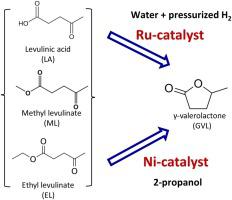Applied Catalysis A: General ( IF 4.7 ) Pub Date : 2021-06-26 , DOI: 10.1016/j.apcata.2021.118276 Adrián García , Pablo J. Miguel , M.P. Pico , I. Álvarez-Serrano , M.L. López , Tomás García , Benjamín Solsona

|
Ni-based catalysts supported on sepiolite were synthesized by different preparation procedures for the production of γ-valerolactone from levulinic acid and its esters (methyl levulinate and ethyl levulinate). The optimal performance was related to the formation of tiny nickel particles. Interestingly, the reaction conditions significantly influence the reactivity of the substrates. The catalytic performance of the optimal Ni/sepiolite catalyst was compared with two catalysts of ruthenium (supported on γ-alumina or sepiolite). In all cases, the production of γ-valerolactone depends on both the substrate employed and the reaction media. Overall, the preferred reaction media using the Ni-catalyst is 2-propanol whereas pressurized hydrogen in water is the best alternative for Ru-catalysts. In both cases, a reasonable stability has been observed after 3 cycles. Finally, the use of metallic Zn in an aqueous medium to provide hydrogen could not be considered as an appropriate option due to the lack of a stable behaviour.
中文翻译:

来自乙酰丙酸及其酯的γ-戊内酯:底物和反应介质决定最佳催化剂
以乙酰丙酸及其酯类(乙酰丙酸甲酯和乙酰丙酸乙酯)为原料制备γ-戊内酯,通过不同的制备工艺合成了负载在海泡石上的镍基催化剂。最佳性能与微小镍颗粒的形成有关。有趣的是,反应条件显着影响底物的反应性。将最佳Ni/海泡石催化剂的催化性能与两种钌催化剂(负载在γ-氧化铝或海泡石上)进行了比较。在所有情况下,γ-戊内酯的产生取决于所使用的底物和反应介质。总体而言,使用 Ni 催化剂的优选反应介质是 2-丙醇,而水中的加压氢气是 Ru 催化剂的最佳替代品。在这两种情况下,在 3 个循环后观察到合理的稳定性。最后,由于缺乏稳定的行为,在水性介质中使用金属锌来提供氢气不能被视为合适的选择。











































 京公网安备 11010802027423号
京公网安备 11010802027423号